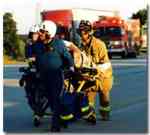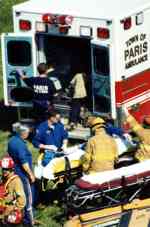Basic Safety Rules and Common Sense:
- Never fly near power lines!
- If you are careless enough to get your kite caught in a power line,
DON'T TOUCH THE LINES OR THE KITE! Power lines carry well over 7,000 volts and the electricity can easily travel
down your kite lines to you regardless of the type of line you are using. IT CAN AND PROBABLY WILL KILL YOU!
If you kite does get stuck in a power line, immediately let go of the lines and handles and move away, call your
local utility company and tell them what has happened and then secure the area, making sure nobody else gets
hurt or killed by the kite and/or it's lines.
- Never fly in stormy weather! Ben Franklin was very lucky not to have been killed by his
experiment. Lightning usually carries more voltage than power lines and it can strike at any time and
any place. Putting a kite in the air in stormy weather makes YOU a giant lightning rod and the lightning WILL find you.
You could be seriously injured or even killed.
- Never use metallic flying line.
- Always be aware of your surroundings and mindful of others. Be especially aware of what is behind you like
other people and children, kite bags, coolers, chairs, cliffs, drop-offs, holes, fences, etc... You would be surprised how many
kiting injuries occur by people falling over things while lunging backwards to keep their kite in the air or by people falling off of cliffs and other drop-offs.
- Be considerate of others, everybody has the right to enjoy the park and other public areas just as much
as kite flyers do. Don't fly noisy kites if it disturbs others, don't be rude and inconsiderate to parties, gatherings, or
other types of activities. Be patient with children and spectators, they probably are not aware of the dangers that are associated with our sport and are usually
only curious to see what you are doing. In the end, it will give all kite flyers a good name and make us all more welcome everywhere.
- Never scare animals, especially horses with riders. There is never any good that will come from this type of activity.
- Never fly your kite near or over people. Some kites have the ability to reach speeds over 80 MPH. If
your kite ever did strike someone at that speed, the results could be fatal. Even slower moving power kites can send someone
to the hospital room if they were hit by one. Kites will also put extreme tension on the kite lines making them razor sharp,
any line under tension can cause severe cuts, bruises and burns if it comes into contact with anyone at any speed. Spectators DO NOT understand
this and may not know they are in danger, especially young children. Politely instruct all
spectators to stand behind when your kite is being flown. Even spectators that are beyond the reach of your lines could be in danger
if your line breaks and your kite flies out of control. Remember, the safety of others is always the responsibility of the flyer!
- Avoid all obstacles; besides the obvious risk of entanglement in trees, you should not fly near roads & vehicles
and make sure that your flying area does not have obstructions such as posts and holes. Flying your kite near roads or freeways is
dangerous because your kite may accidentally land on the road causing an accident. Drivers may also become distracted by your kite and
lose control of their vehicle. If your kite strikes a vehicle, it will cause serious damage to the vehicle and your kite, causing
a large expense and/or personal injury.
- Avoid other kites, kite lines and kite flyers. The line used by stunt kite
flyers has a very low melting point and can easily be severed by nylon line. You will then
discover the stunt kite flyer also has a low melting point!
- Special rules apply when flying within two miles of an airport. FAA regulations prohibit the use of any kite weighing
over five pounds, and kites are not permitted to fly on line longer than 500 feet in length. Check
with your local authorities for any other restrictions that may be unique to your area.
- Always use extreme caution when flying large kites. It is advisable to wear gloves when handling large kites.
Never leave them unattended. Winds can change direction and intensity very quickly.
- Sport & power kites need to be flown with particular care. Make sure that
your kite can not self launch when setting up your kite and follow all safety rules and instructions
for the type of sport or power kite you are flying. If a kite you plan to fly did not come
with safety instructions, make sure you acquire the proper knowledge to safely control the kite.
Periodically inspect your kite for broken or split spars and verify that the bridle and flying lines
are not frayed or worn. Also, do not leave your kite lines unattended while
staked or lying on the ground. You do not want people to trip over your kite lines.
- Fastening yourself to your kite line can lead to painful, serious injuries. Extra caution should be used if using a harness when
traction or power flying. A harness should not be engaged if there is any doubt that total
control can be maintained. It is also advisable to use a quick release system if you are
attached to your kite.
- Never over power yourself with a kite too large for the current wind conditions. Never fly a kite that
you can not safely control.
|






